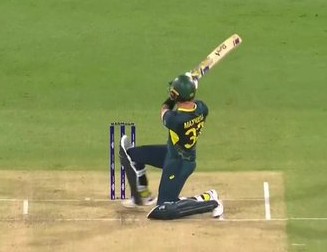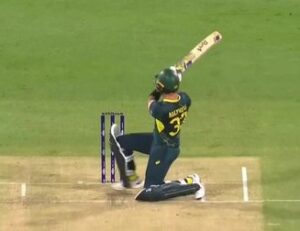The reverse sweep is one of the most audacious and innovative shots in cricket, a stroke that has evolved from a risky gamble to a mainstream weapon in a batsman’s arsenal. Once considered unorthodox, this shot has become a hallmark of modern cricket, particularly in limited-overs formats like T20 and ODIs, where adaptability and 360-degree scoring are crucial. From its origins to its tactical significance, the reverse sweep has reshaped how batsmen approach spin bowling and field placements. Let’s dive into the mechanics, history, and impact of the reverse sweep in cricket.
What is the Reverse Sweep?
The reverse sweep is a batting shot where a right-handed batsman (or left-hander) sweeps the ball in the opposite direction of a conventional sweep. In a traditional sweep, a right-handed batsman gets low, brings the bat down in a horizontal arc, and hits a ball from outside off stump towards the leg side. In contrast, the reverse sweep involves the batsman reversing their grip or bat angle to play a similar sweeping motion but directing the ball towards the off side—often towards point or third man—against its natural trajectory.
The shot is typically played against spinners, especially off-spinners or leg-spinners, to counter their line and disrupt field placements. It requires immense skill, timing, and confidence, as the batsman must connect with the ball cleanly while playing against its spin, often risking an edge or a miss that could lead to an LBW or caught dismissal.
Mechanics of the Reverse Sweep
Executing a reverse sweep demands precision and practice. Here’s how it’s typically played:
- Stance and Positioning: The batsman starts in a conventional stance but prepares to get low as the bowler delivers the ball. They often pre-meditate the shot, reading the bowler’s line (usually outside off for a right-hander) and length (ideally full or slightly short).
- Grip Adjustment: The batsman either reverses their grip on the bat (top hand becomes the bottom hand) or keeps the grip the same but rotates the bat face at the point of contact to direct the ball towards the off side. Modern players like Jos Buttler often maintain a standard grip but use wristwork to manipulate the bat angle.
- Body Movement: The batsman gets down on one knee (similar to a conventional sweep), lowering their center of gravity. The head stays over the ball to maintain balance and control.
- Bat Swing: The bat sweeps horizontally, but the face is angled to scoop or guide the ball towards the off side. Timing is critical—the ball must be met with the full face of the bat to avoid an edge.
- Follow-Through: A controlled follow-through ensures the ball travels along the ground or with an aerial trajectory, depending on the intent (e.g., to clear infielders or keep it safe).
The reverse sweep is most effective against spinners bowling a good length or fuller, as it allows the batsman to access areas of the field where fielders are sparse, such as behind point or third man.
History of the Reverse Sweep
The reverse sweep’s origins are debated, but it is widely believed to have been popularized in the 1970s by Pakistani batsman Mushtaq Mohammad, who used it as a surprise tactic against spin bowling. Mushtaq, known for his inventive strokeplay, employed the shot to counter the dominance of spinners on turning pitches, particularly in the subcontinent. His brother, Hanif Mohammad, also experimented with similar unorthodox shots, laying the groundwork for its adoption.
The shot gained global attention during the 1990s when England’s Mike Gatting infamously played a reverse sweep against Australia’s Allan Border in the 1987 World Cup final, only to be caught out, sparking debates about its reliability. At the time, the reverse sweep was seen as reckless, often criticized by purists who favored traditional shots like the cover drive or lofted cover shot.
However, the shot’s reputation transformed in the 2000s with the rise of limited-overs cricket. Players like England’s Kevin Pietersen and New Zealand’s Brendon McCullum mastered the reverse sweep, using it to disrupt spinners and score in unconventional areas. Pietersen, in particular, made the shot his signature, playing it with flair against the likes of Muttiah Muralitharan and Harbhajan Singh. In the T20 era, players like AB de Villiers, Glenn Maxwell, Jos Buttler, and Rishabh Pant have taken the reverse sweep to new heights, often combining it with variations like the reverse scoop or switch hit to create a 360-degree batting approach.
Tactical Significance
The reverse sweep has become a tactical masterstroke for several reasons:
- Disrupting the Bowler’s Line: Spinners often bowl outside off stump to right-handers, expecting them to play towards the leg side or defend. The reverse sweep forces the bowler to rethink their line, as it allows the batsman to score on the off side, an area typically left open.
- Exploiting Field Placements: Captains often set fields with multiple fielders on the leg side against spinners (e.g., a deep square leg or midwicket). The reverse sweep targets the off side, where gaps exist, such as point or third man, forcing fielders to spread out and creating more scoring opportunities.
- Countering Spin: On turning pitches, playing with the spin can be risky due to bounce or sharp turn. The reverse sweep allows the batsman to play against the spin in a controlled manner, reducing the risk of edging to slip or being bowled.
- Psychological Edge: The shot puts pressure on the bowler and captain, as it signals the batsman’s willingness to take risks and dominate. A well-executed reverse sweep can demoralize the opposition, forcing them to change their strategy.
- Adaptability in T20 Cricket: In the fast-paced T20 format, where scoring rates are critical, the reverse sweep helps batsmen access unconventional areas of the field, keeping the scoreboard ticking even against tight bowling.
Challenges and Risks
While the reverse sweep is a high-reward shot, it comes with inherent risks:
- Misjudgment: If the ball spins more than expected or the length is misread, the batsman risks missing the ball, leading to an LBW or bowled dismissal.
- Edging: Playing against the spin increases the chance of an edge, which can be caught by the wicketkeeper or slip fielders.
- Field Adjustments: A smart captain may place a fielder at third man or point to counter the shot, reducing its effectiveness.
- Criticism: Traditionalists often view the shot as unnecessary, arguing that it deviates from classical batting techniques. A failed reverse sweep in a crucial moment can draw scrutiny, as seen with Mike Gatting’s dismissal in 1987.
Despite these risks, modern batsmen practice the shot extensively in the nets, honing their technique to minimize errors and maximize impact.
Impact on Modern Cricket
The reverse sweep has fundamentally changed how batsmen approach spin bowling, particularly in limited-overs cricket. In the T20 era, where innovation is key, the shot has become a staple for aggressive batsmen looking to dominate from the outset. Players like Jos Buttler and Glenn Maxwell have elevated the reverse sweep into an art form, often using it to score boundaries or even sixes by lofting the ball over the infield.
The shot has also influenced coaching and training methods. Young cricketers are now taught the reverse sweep as part of their development, with batting coaches emphasizing wristwork, balance, and decision-making. In women’s cricket, too, players like Smriti Mandhana and Harmanpreet Kaur have adopted the shot, showcasing its universal appeal.
Moreover, the reverse sweep has forced bowlers and captains to adapt. Spinners now vary their pace, flight, and angles more frequently to counter the shot, while captains set unconventional fields, such as a deep third man, to neutralize its impact. This cat-and-mouse game between batsman and bowler has added a thrilling dimension to cricket, enhancing its tactical depth.
Notable Reverse Sweep Moments
- Mike Gatting, 1987 World Cup Final: Gatting’s ill-fated reverse sweep against Allan Border led to his dismissal at a crucial juncture, costing England the match and sparking debates about the shot’s viability.
- Kevin Pietersen vs. Muttiah Muralitharan, 2006: Pietersen’s audacious reverse sweeps against the legendary spinner during a Test match in Sri Lanka showcased the shot’s potential to dominate even the best bowlers.
- AB de Villiers, IPL 2016: De Villiers played a series of reverse sweeps and scoops against spinners, scoring at a blistering pace and redefining T20 batting.
- Jos Buttler, 2022 T20 World Cup: Buttler’s reverse sweep against Pakistan’s Shadab Khan in the final helped England maintain momentum, contributing to their title-winning campaign.
Conclusion
The reverse sweep is a testament to cricket’s evolution, a shot that blends creativity, skill, and bravery. From its early days as an unorthodox experiment to its current status as a mainstream scoring option, the reverse sweep has empowered batsmen to take control against spin bowling and rewrite the rules of engagement. While it carries risks, its rewards—both in terms of runs and psychological dominance—make it a vital tool in modern cricket. As the game continues to evolve, the reverse sweep will remain a symbol of innovation, reminding us that in cricket, as in life, thinking outside the box can lead to extraordinary results.












Leave a Reply